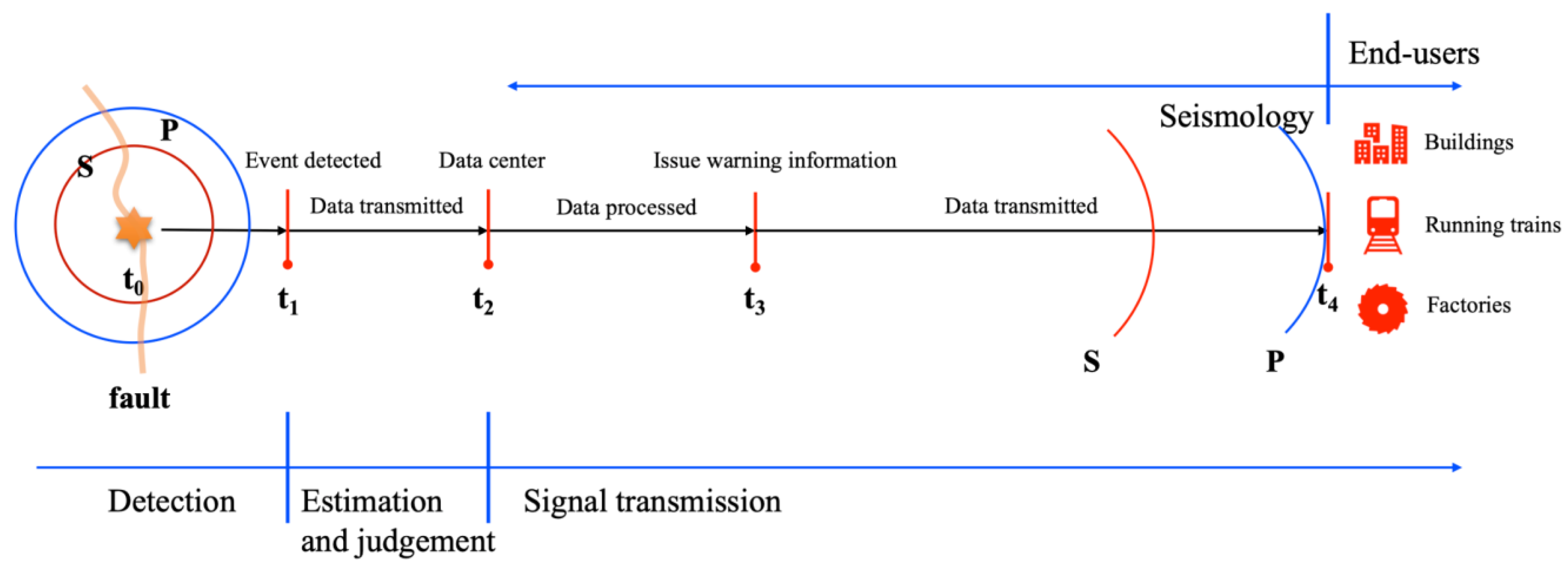Next-Generation EEW Empowered by NDSHA: From Concept to Implementation
Abstract
1. Introduction
2. Earthquake Early Warning (EEW)
2.1. Limits of Current EEW
2.2. Next-Generation of EEW (Regional EEW + SHA)
2.2.1. From Concept to Real Implementation
2.2.2. Improvement and Alternative
3. NDSHA Approach: Methodology
4. EEW2.0
4.1. Simple Classification of Earthquakes, and Their Damaging Potential, from Magnitude
4.2. Hazard Database: MMI Maps
- (1)
- The seismogenic zone is defined by the coordinates 99.6°~102.8° E, 28.8°~32.2° N, i.e., the whole XSH.
- (2)
- The source is placed in the first cell (99.6°~99.8° E, 32.0°~32.2° N), and its magnitude is set as 5.0.
- (3)
- All the 272 (smoothed) sources related with XSH are characterized, for simplification of computing procedures, by the same rupture and the focal mechanism characteristic of XSH (strike = 146°, dip = 82°, rake = 349°).
- (4)
- The predefined 0.2° × 0.2° cellular grid, corresponding to the cellular structural models referenced by [45], is adopted for the computation of synthetic seismograms at the sites.
- (5)
- For the same source cell defined in (2), the value of magnitude is changed to the next class, and the depth is defined following the predefined rules, iterating for the next 11 (up to the final magnitude class) regional computations in (3).
- (6)
- The magnitude is reset to 5.0 (and the depth to 10 km), the source is moved to the 2nd source cell (99.8°~100.0° E, 32.0°~32.2° N), and steps (2)–(4) are repeated.
4.3. Decision Framework for Alert Notification
4.4. Conceptual Working Mechanism
5. Discussion and Conclusions
Author Contributions
Funding
Data Availability Statement
Acknowledgments
Conflicts of Interest
References
- Cooper, J.D. San Francisco Daily Evening Bulletin. 1868. Available online: https://spectrum.ieee.org/a-brief-history-of-earthquake-warnings (accessed on 18 November 2021).
- Heaton, T.H. A model for a Seismic Computerized Alert Network. Science 1985, 228, 987–990. [Google Scholar] [CrossRef]
- Ben-Menahem, A. A concise history of mainstream seismology: Origins, legacy and perspectives. Bull. Seismol. Soc. Am. 1995, 85, 1202–1225. Available online: https://pubs.geoscienceworld.org/ssa/bssa/article-abstract/85/4/1202/102637/A-concise-history-of-mainstream-seismology-Origins (accessed on 29 September 2021).
- Wenzel, F.; Baur, M.; Fiedrich, F.; Lonescu, C.; Lonescu, M.C. Potential of earthquake early warning systems. Nat. Hazards 2001, 23, 407–416. [Google Scholar] [CrossRef]
- Erdik, M.; Fahjan, Y.; Ozel, O.; Alcik, H.; Mert, A.; Gul, M. Istanbul Earthquake Rapid Response and the Early Warning System. Bull. Earthq. Eng. 2003, 1, 157–163. [Google Scholar] [CrossRef]
- Xu, Y.; Burton, P.W.; Tselentis, G.A. Regional seismic hazard for Revithoussa, Greece: An earthquake early warning Shield and selection of alert signals. Nat. Hazards Earth Syst. Sci. 2003, 3, 757–776. [Google Scholar] [CrossRef][Green Version]
- Allen, R.M.; Kanamori, H. The potential for earthquake early warning in southern California. Science 2003, 300, 786–789. [Google Scholar] [CrossRef]
- Espinosa-Aranda, J.M.; Cuellar, A.; Rodriguez, F.H.; Frontana, B.; Ibarrola, G.; Islas, R.; Garcia, A. The seismic alert system of Mexico (SASMEX): Progress and its current applications. Soil Dyn. Earthq. Eng. 2011, 31, 154–162. [Google Scholar] [CrossRef]
- Lancieri, M.; Fuenzalida, A.; Ruiz, S.; Madariaga, R. Magnitude scaling of early-warning parameters for the Mw 7.8 Tocopilla, Chile. Bull. Seism. Soc. Am. 2011, 101, 447–463. [Google Scholar] [CrossRef]
- Kamigaichi, O.; Saito, M.; Doi, K.; Matsumori, T.; Tsukada, S.; Takeda, K.; Shimoyama, T.; Nakamura, K.; Kiyomoto, M.; Watanabe, Y. Earthquake early warning in Japan: Warning the general public and future prospects. Seismol. Res. Lett. 2009, 80, 717–726. [Google Scholar] [CrossRef]
- Nakamura, H.; Horiuchi, S.; Wu, C.J.; Yamamoto, S.; Rydelek, P.A. Evaluation of the real-time earthquake information system in Japan. Geophys. Res. Lett. 2009, 36, L00B01. [Google Scholar] [CrossRef]
- Fujinawa, Y.; Noda, Y. Japan’s earthquake early warning system on 11 March 2011: Performance, shortcomings and changes. Earthq. Spectra 2013, 29, 341–368. [Google Scholar] [CrossRef]
- Picozzi, M.; Zollo, A.; Brondi, P.; Colombelli, S.; Elia, L.; Martino, C. Exploring the feasibility of a nationwide earthquake early warning system in Italy. J. Geophys. Res. Solid Earth 2015, 120, 2446–2465. [Google Scholar] [CrossRef]
- Iannaccone, G.; Zollo, A.; Elia, L.; Convertito, V.; Satriano, C.; Martino, C.; Festa, G.; Lancieri, M.; Bobbio, A.; Stabile, T.A.; et al. A prototype system for earthquake early-warning and alert management in southern Italy. Bull. Earthq. Eng. 2010, 8, 1105–1129. [Google Scholar] [CrossRef]
- Satriano, C.; Elia, L.; Martino, C.; Lancieri, M.; Zollo, A.; Lannaccone, G. PRESTo, the earthquake early warning system for Southern Italy: Concepts, capabilities and future perspectives. Soil Dyn. Earthq. Eng. 31, 137–153. [CrossRef]
- Heidari, R.; Shomali, Z.H.; Ghayamghamian, M.R. Magnitude-scaling relations using period parameters tau(c) and tau(max)(p), for Tehran region, Iran. Geophys. J. Int. 2013, 192, 275–284. [Google Scholar] [CrossRef]
- Enferadi, S.; Shomali, Z.H.; Niksejel, A. Feasibility study of earthquake early warning in Tehran, Iran. J. Seismol. 2021, 25, 1127–1140. [Google Scholar] [CrossRef]
- Picozzi, M.; Bindi, D.; Pittore, M.; Kieling, K.; Parolai, S. Real-time risk assessment in seismic early warning and rapid response: A feasibility study in Bishkek (Kyrgyzstan). J. Seism. 2013, 17, 485–505. [Google Scholar] [CrossRef]
- Kanamori, H. The diversity of the physics of earthquakes. Proc. Jpn. Acad. Ser. B Phys. Biol. Sci. 2004, 80, 297–316. [Google Scholar] [CrossRef]
- Rundle, J.; Stein, S.; Donnellan, A.; Turcotte, D.L.; Klein, W.; Saylor, C. The complex dynamics of earthquake fault systems: New approaches to forecasting and nowcasting of earthquakes. Rep. Prog. Phys. 2021, 84, 076801. [Google Scholar] [CrossRef]
- Kanamori, H. Real-time seismology and earthquake damage mitigation. Annu. Rev. Earth Planet. Sci. 2005, 33, 195–214. [Google Scholar] [CrossRef]
- Wu, Y.M.; Kanamori, H. Development of an Earthquake Early Warning System using real-time strong motion signals. Sensors 2008, 8, 1–9. [Google Scholar] [CrossRef] [PubMed]
- Horiuchi, S.; Horiuchi, Y.; Yamamoto, S.; Nakamura, H.; Wu, C.J.; Rydelek, P.A.; Kachi, M. Home seismometer for earthquake early warning. Geophys. Res. Lett. 2009, 36, L00B04. [Google Scholar] [CrossRef]
- Minson, S.E.; Brooks, B.A.; Glennie, C.L.; Murray, J.R.; Langbein, J.O.; Owen, S.E.; Heaton, T.H.; Lannucci, R.A.; Hauser, D.L. Crowdsourced earthquake early warning. Sci. Adv. 2015, 1, e1500036. [Google Scholar] [CrossRef]
- Wang, Y.; Li, S.Y.; Song, J.D. Threshold-based evolutionary magnitude estimation for an earthquake early warning system in the Sichuan-Yunnan region, China. Sci. Rep. 2020, 10, 21055. [Google Scholar] [CrossRef]
- Hilbring, D.; Titzschkau, T.; Buchmann, A.; Bonn, G.; Wenzel, F.; Hohnecker, E. Earthquake early warning for transport lines. Nat. Hazards 2014, 70, 1795–1825. [Google Scholar] [CrossRef]
- Pagano, L.; Sica, S. Earthquake early warning for earth dams: Concepts and objectives. Nat. Hazards 2013, 66, 303–318. [Google Scholar] [CrossRef]
- Cheng, M.H.; Wu, S.; Heaton, T.H.; Beck, J.L. Earthquake early warning application to buildings. Eng. Struct. 2014, 60, 155–164. [Google Scholar] [CrossRef]
- Kubo, T.; Hisada, Y.; Murakami, M.; Kosuge, F.; Hamano, K. Application of an earthquake early warning system and a real-time strong motion monitoring system in emergency response in a high-rise building. Soil Dyn. Earthq. Eng. 2011, 31, 231–239. [Google Scholar] [CrossRef]
- Maruyama, Y.; Yamazaki, F.; Sakaya, M. Experiments of earthquake early warning to Expressway Drivers using synchronized driving simulators. Earthq. Spectra 2009, 25, 347–360. [Google Scholar] [CrossRef]
- Cremen, G.; Galasso, C. Earthquake early warning: Recent advances and perspective. Earth Sci. Rev. 2020, 205, 103184. [Google Scholar] [CrossRef]
- Panza, G.F.; Romanelli, F.; Vaccari, F. Seismic wave propagation in laterally. heterogeneous anelastic media: Theory and application to seismic zonation. Adv. Geophys. 2001, 43, 1–95. [Google Scholar] [CrossRef]
- Panza, G.F.; Kossobokov, V.G.; Laor, E.; De Vivo, B. Earthquakes and Sustainable Infrastructure: Neodeterministic (NDSHA) Approach Guarantees Prevention Rather than Cure, 1st ed.; Elsevier: Amsterdam, The Netherlands, 2021; ISBN 978-0-12-823503-4. [Google Scholar]
- Deng, Q.D.; Zhang, P.Z.; Ran, Y.K.; Yang, X.P.; Min, W.; Chen, L.C. Active tectonics and earthquake activities in China. Earthq. Sci. Front. 2003, 10, 66–73, (In Chinese with English abstract). [Google Scholar]
- Gorshkov, A.; Kossobokov, V.; Soloviev, A. Recognition of earthquake-prone areas. In Nonlinear Dynamics of the Lithosphere and Earthquake Prediction; Vladimir, K.B., Soloviev, A.A., Eds.; Springer: Berling/Heidelberg, Germany, 2003; pp. 239–310. ISBN 978-3-662-05298-3. [Google Scholar]
- Satriano, C.; Wu, Y.M.; Zollo, A.; Kanamori, H. Earthquake early warning: Concepts, methods and physical grounds. Soil Dyn. Earthq. Eng. 2011, 31, 106–118. [Google Scholar] [CrossRef]
- Allen, M.R.; Melgar, D. Earthquake Early Warning: Advances, scientific challenges, and societal Needs. Annu. Rev. Earth Planet. Sci. 2019, 47, 361–388. [Google Scholar] [CrossRef]
- Velazquez, O.; Pescaroli, G.; Cremen, G.; Galasso, C. A review of the technical and socio-organizational components of earthquake early warning systems. Front. Earth Sci. 2020, 8, 533498. [Google Scholar] [CrossRef]
- Oliveira, C.S.; de Sa, F.M.; Lopes, M.; Ferreira, M.A.; Pais, I. Early warning systems: Feasibility and end-users’ point of view. Pure Appl. Geophys. 2015, 172, 2353–2370. [Google Scholar] [CrossRef]
- Xu, H. Minimizing the ripple effect caused by operational risks in a make-to-order supply chain. Int. J. Phys. Distrib. Logist. Manag. 2020, 50, 381–402. [Google Scholar] [CrossRef]
- Wu, Y.M.; Kanamori, H. Rapid assessment of damage potential of earthquakes in Taiwan from the beginning of P waves. Bull. Seism. Soc. Am. 2005, 95, 1181–1185. [Google Scholar] [CrossRef]
- National Research Council. Living on an Active Earth: Perspectives on Earthquake Science; National Academies Press: Cambridge, MA, USA, 2003; ISBN 978-0309065627. [Google Scholar]
- Panza, G.F.; La Mura, C.; Peresan, A.; Romanelli, F.; Vaccari, F. Seismic hazard scenarios as preventive tools for a disaster resilient society. Adv. Geophys. 2012, 53, 93–165. [Google Scholar] [CrossRef]
- Rugarli, P.; Vaccari, F.; Panza, G.F. Seismogenic nodes as a viable alternative to seismogenic zones and observed seismicity for the definition of seismic hazard at regional scale. Vietnam J. Earth Sci. 2019, 41, 289–304. [Google Scholar] [CrossRef]
- Zhang, Y.; Romanelli, F.; Vaccari, F.; Peresan, A.; Jiang, C.S.; Wu, Z.L.; Gao, S.H.; Kossobokov, G.V.; Panza, G.F. Seismic hazard maps based on Neo-deterministic Seismic Hazard Assessment for China Seismic Experimental Site and its adjacent areas. Eng. Geol. 2020, 291, 106208. [Google Scholar] [CrossRef]
- Fahjan, Y.M.; Alcik, H.; Sari, A. Applications of cumulative absolute velocity to urban earthquake early warning systems. J. Seismol. 2011, 15, 355–373. [Google Scholar] [CrossRef]
- McGuire, R.K. Probabilistic seismic hazard analysis: Early history. Earthquake Engng Struct. Dyn. 2008, 37, 329–338. [Google Scholar] [CrossRef]
- Gasparini, P.; Manfredi, G.; Zschau, J. Earthquake early warning as a tool for improving society’s resilience and crisis response. Soil Dyn. Earthq. Eng. 2011, 31, 267–270. [Google Scholar] [CrossRef]
- Wyss, M.; Nekrasova, A.; Kossobokov, V. Errors in expected human losses due to incorrect seismic hazard estimates. Nat. Hazards 2012, 62, 927–935. [Google Scholar] [CrossRef]
- Panza, G.; Kossobokov, V.G.; Peresan, A.; Nekrasova, A. Chapter 12: Why are the standard probabilistic methods of estimating seismic hazard and risks too often wrong. In Earthquake Hazard, Risk and Disasters; Academic Press: Cambridge, MA, USA, 2014; pp. 309–357. ISBN 978-0-12-394848-9. [Google Scholar]
- Panza, G.F.; Bela, J. NDSHA: A new paradigm for reliable seismic hazard assessment. Eng. Geol. 2020, 275, 105403. [Google Scholar] [CrossRef]
- Panza, G.F.; Bela, J. Reliable seismic hazard assessment: NDSHA. Albanian J. Nat. Tech. Sci. 2021, 26, in press. [Google Scholar]
- Bela, J.; Panza, G.F. NDSHA—The new paradigm for RSHA—An updated review. Vietnam J. Earth Sci. 2021, 43, 111–188. [Google Scholar] [CrossRef]
- Panza, G.F. NDSHA: Robust and Reliable Seismic Hazard Assessment. Proceedings of International Conference on Disaster Risk Mitigation, Dhaka, Bangladesh, 23–24 September 2017. [Google Scholar]
- Panza, G.F.; Vaccari, F.; Costa, G.; Suhadolc, P.; Fäh, D. Seismic input modeling for zoning and microzoning. Earthquake Spectra 1996, 12, 529–566. [Google Scholar] [CrossRef]
- Reiter, L. Earthquake Hazard Analysis: Issues and Insights; Columbia University Press: New York, NY, USA, 1990; ISBN 978-0231513203. [Google Scholar]
- Peresan, A.; Zuccolo, E.; Vaccari, F.; Gorshkov, A.; Panza, G.F. Neo-deterministic seismic hazard and pattern recognition techniques: Time-dependent scenarios for North-Eastern Italy. Pure Appl. Geophys. 2011, 168, 583–607. [Google Scholar] [CrossRef]
- Parvez, I.A.; Vaccari, F.; Panza, G.F. A deterministic seismic hazard map of India and adjacent areas. Geophys. J. Int. 2003, 155, 489–508. [Google Scholar] [CrossRef]
- Markušić, S.; Suhadolc, P.; Herak, M.; Vaccari, F. A contribution to seismic hazard assessment in Croatia from deterministic modeling. In Seimic Hazard of the Circum-Pannonian Region; Panza, G., Radulian, M., Trifu, C., Eds.; Birkhauser Verlag: Basel, Switzerland, 2000; ISBN 978-3-0348-8415-0. [Google Scholar]
- Brandmayr, E.; Vaccari, F.; Romanelli, F.; Vlahovic, G.; Panza, G.F. Neo-deterministic seismic hazard maps of Kosovo. Vietnam J. Earth Sci. 2021, 43, 1–10. [Google Scholar] [CrossRef]
- Mourabit, T.; Abou Elenean, K.M.; Ayadi, A.; Benouar, D.; Ben Suleman, A.; Bezzeghoud, M.; Cheddadi, A.; Chourak, M.; ElGabry, M.N.; Harbi, A.; et al. Neo-deterministic seismic hazard assessment in North Africa. J. Seismol. 2014, 18, 301–318. [Google Scholar] [CrossRef]
- El-Sayed, A.; Vaccari, F.; Panza, G.F. Deterministic seismic hazard in Egypt. Geophys. J. Int. 2001, 144, 555–567. [Google Scholar] [CrossRef]
- Parvez, I.A.; Magrin, A.; Vaccari, F.; Ashish; Mir, R.; Peresan, A.; Panza, G.F. Neo-deterministic seismic hazard scenarios for India—A preventive tool for disaster mitigation. J. Seismol. 2017, 21, 1559–1575. [Google Scholar] [CrossRef]
- Ding, Z.F.; Vaccari, F.; Chen, Y.T.; Panza, G.F. Deterministic seismic hazard map in North China. In Earthquake Hazard, Risk, and Strong Ground Motion; Chen, Y.T., Panza, F.G., Wu, Z.L., Eds.; Seismological Press: Beijing, China, 2004; pp. 351–360. ISBN 7-5028-2506-1. [Google Scholar]
- Panza, G.F. Synthetic seismograms: The Rayleigh waves modal summation. J. Geophys. 1985, 58, 125–145. [Google Scholar]
- Florsch, N.; Fäh, D.; Suhadolc, P.; Panza, G.F. Complete synthetic seismograms for high-frequency multimode SH-waves. Pure Appl. Geophys. 1991, 136, 529–560. [Google Scholar] [CrossRef]
- Kárník, V.; Algermissen, S.T. Seismic zoning. In The Assessment and Mitigation of Earthquake Risk. NICI; United Nations Educational, Scientific and Cultural Organization: Paris, France, 1978; pp. 11–47. ISBN 92-3-101451-X. [Google Scholar]
- Båth, M. Introduction to Seismology; Birkhäuser Verlag: Basel, Switzerland, 1973. [Google Scholar]
- Chung, I.A.; Henson, I.; Allen, M.R. Optimizing Earthquake Early Warning Performance: ElarmS-3. Seism. Res. Lett. 2019, 90, 727–743. [Google Scholar] [CrossRef]
- Bormann, P.; Liu, R.F.; Ren, X.; Gutdeutsch, R.; Kaiser, D.; Castellaro, S. Chinese National Network magnitudes, their relation to NEIC magnitudes, and recommendations for new IASPEI magnitude standards. Bull. Seismol. Soc. Am. 2007, 97, 114–127. [Google Scholar] [CrossRef]
- Ismail-Zadeh, A.; Kossobokov, V. Earthquake prediction, M8 Algorithm. In Encyclopedia of Solid Earth Geophysics; Gupta, H.K., Ed.; Springer: Amsterdam, The Netherlands, 2020; pp. 1–5. ISBN 978-90-481-8702-7. [Google Scholar]
- Kossobokov, V. Earthquake prediction: 20 years of global experiment. Nat. Hazards 2013, 69, 1155–1177. [Google Scholar] [CrossRef]
- Panza, G.F.; Prozorov, A.; Suhadolc, P. Is there a correlation between lithosphere structure and statistical properties of seismicity? Terra Nova 1990, 2, 585–595. [Google Scholar] [CrossRef]
- Minson, S.E.; Meier, M.A.; Baltay, A.S.; Hanks, T.C.; Cochran, E.S. The limits of earthquake early warning: Timeliness of ground motion estimates. Sci. Adv. 2018, 4, eaaq0504. [Google Scholar] [CrossRef] [PubMed]




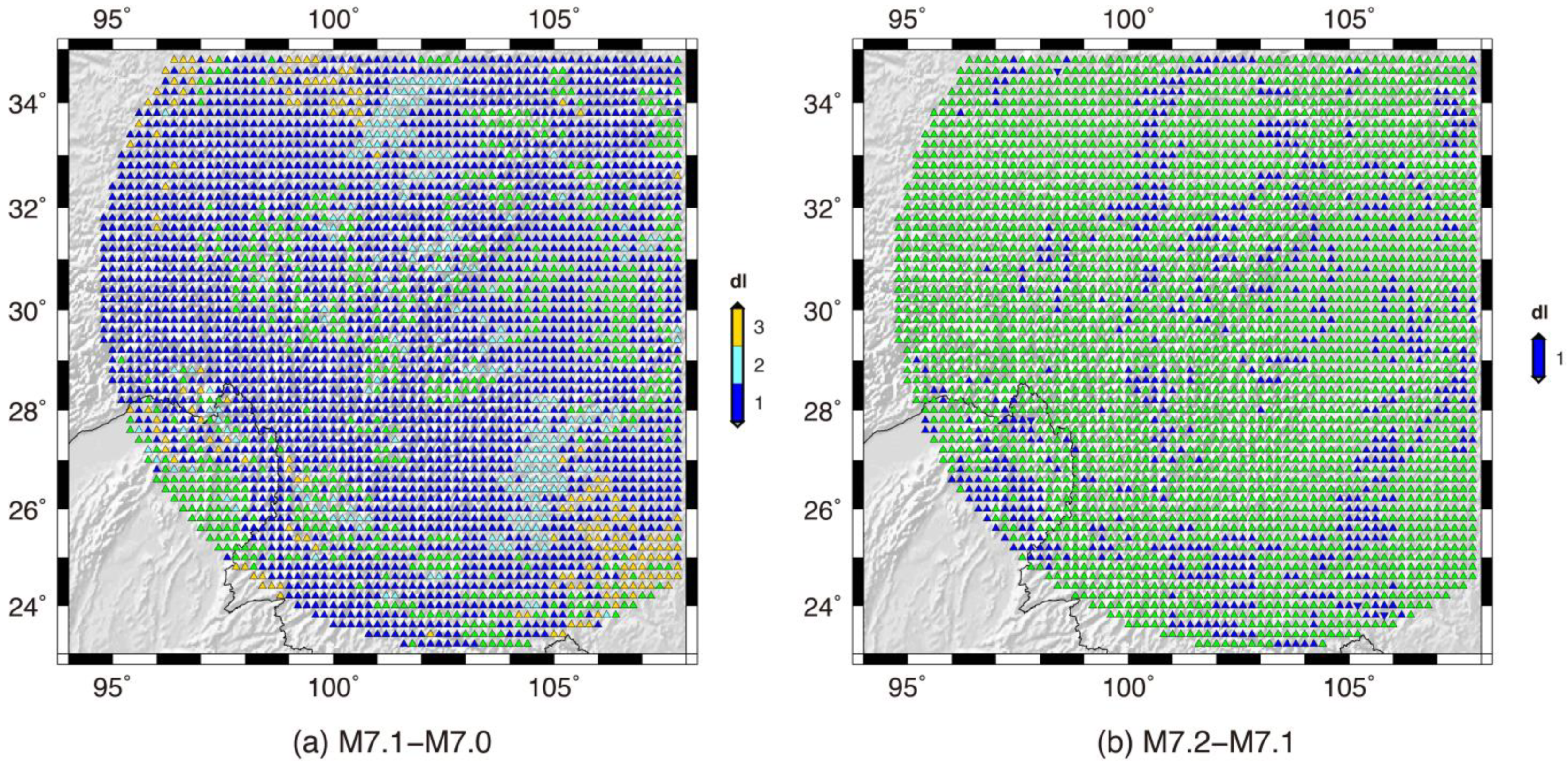
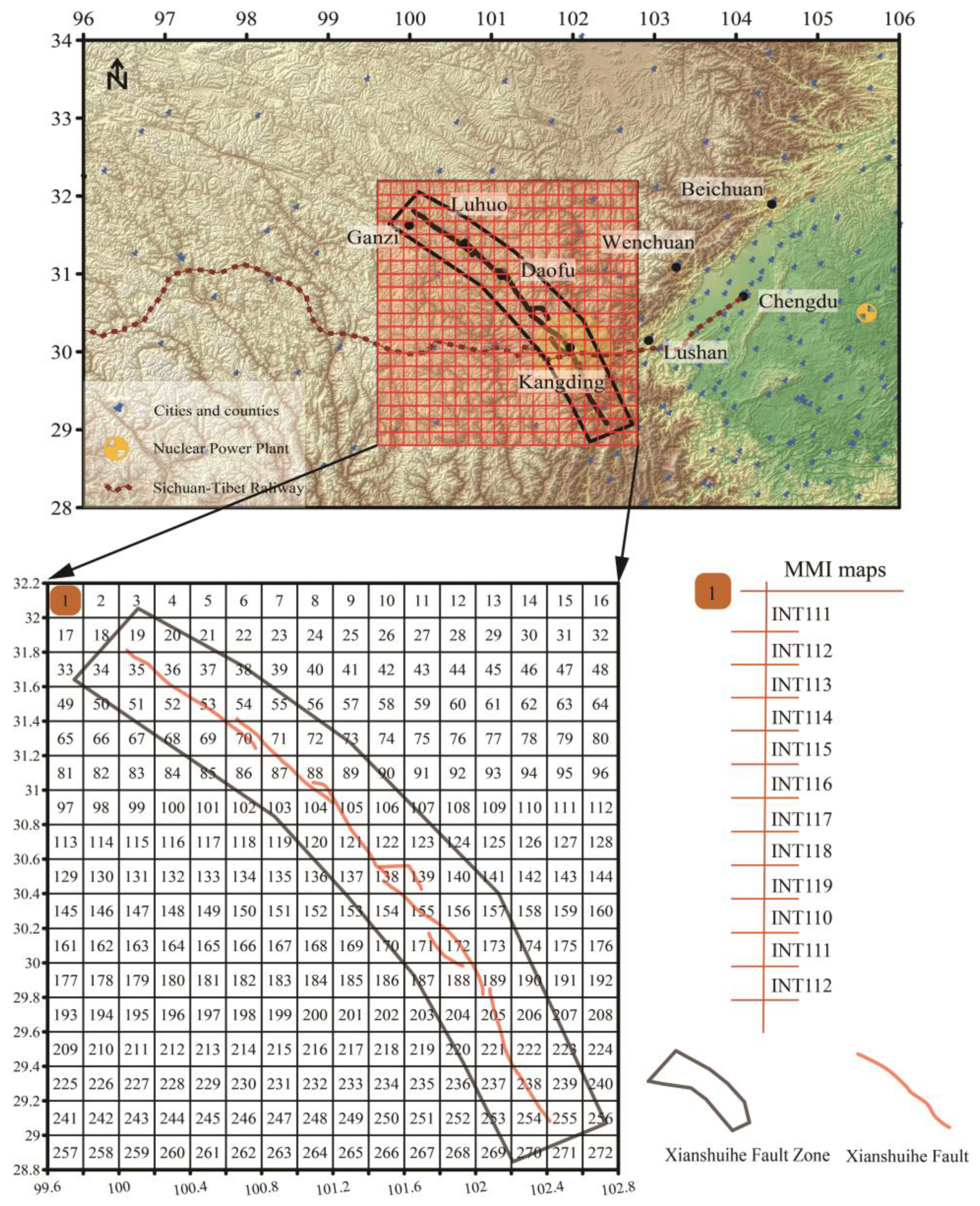
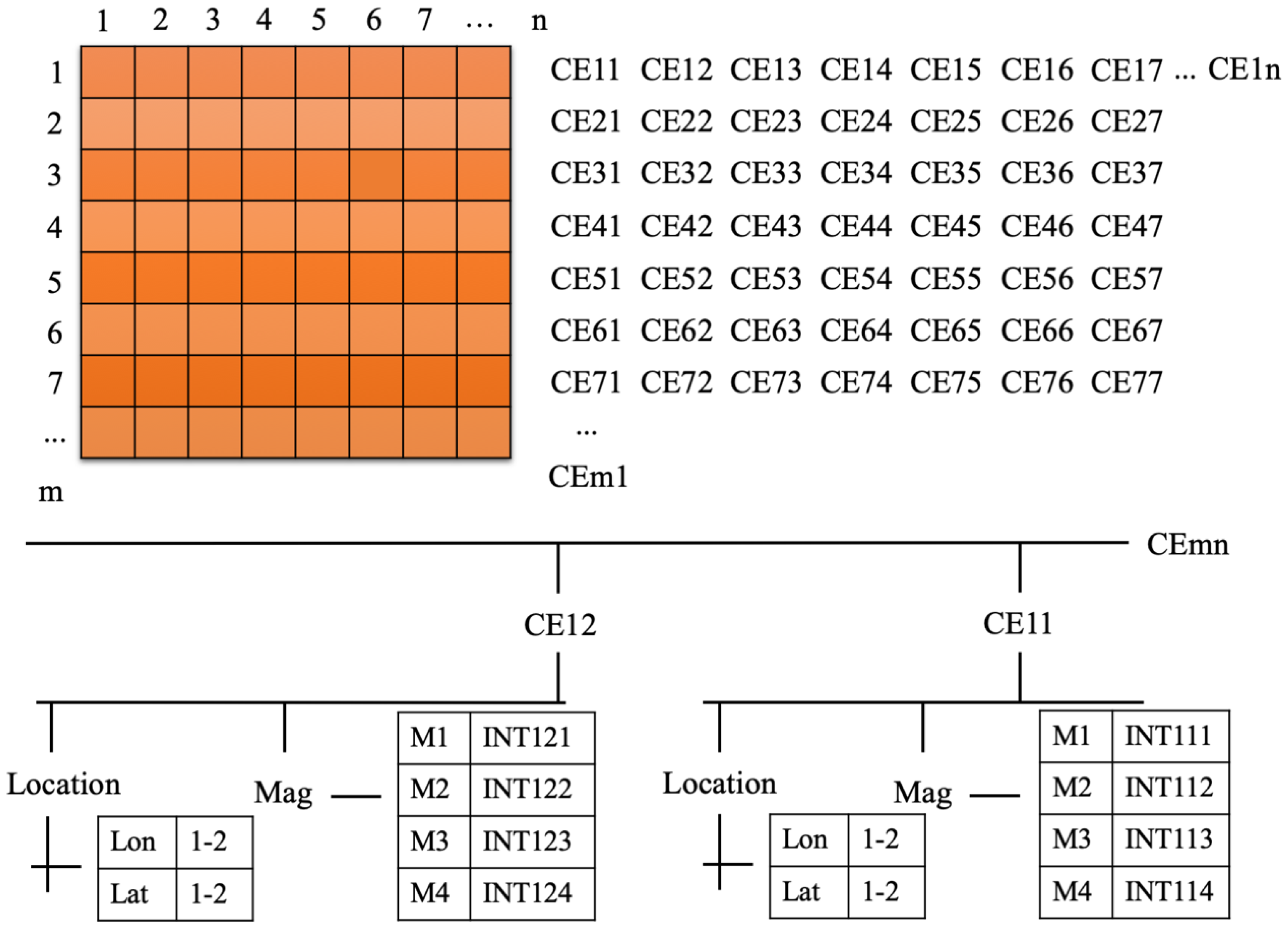
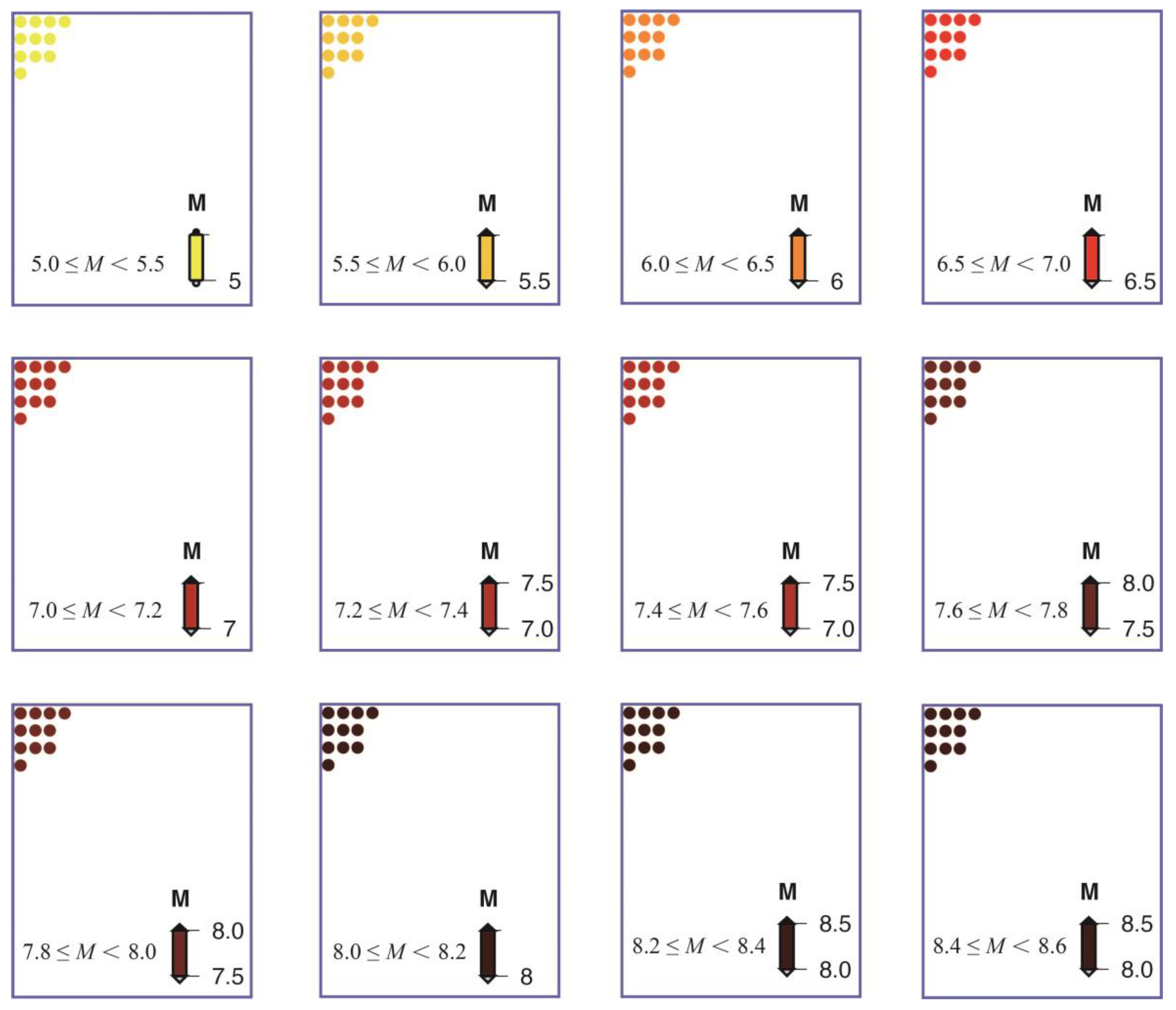
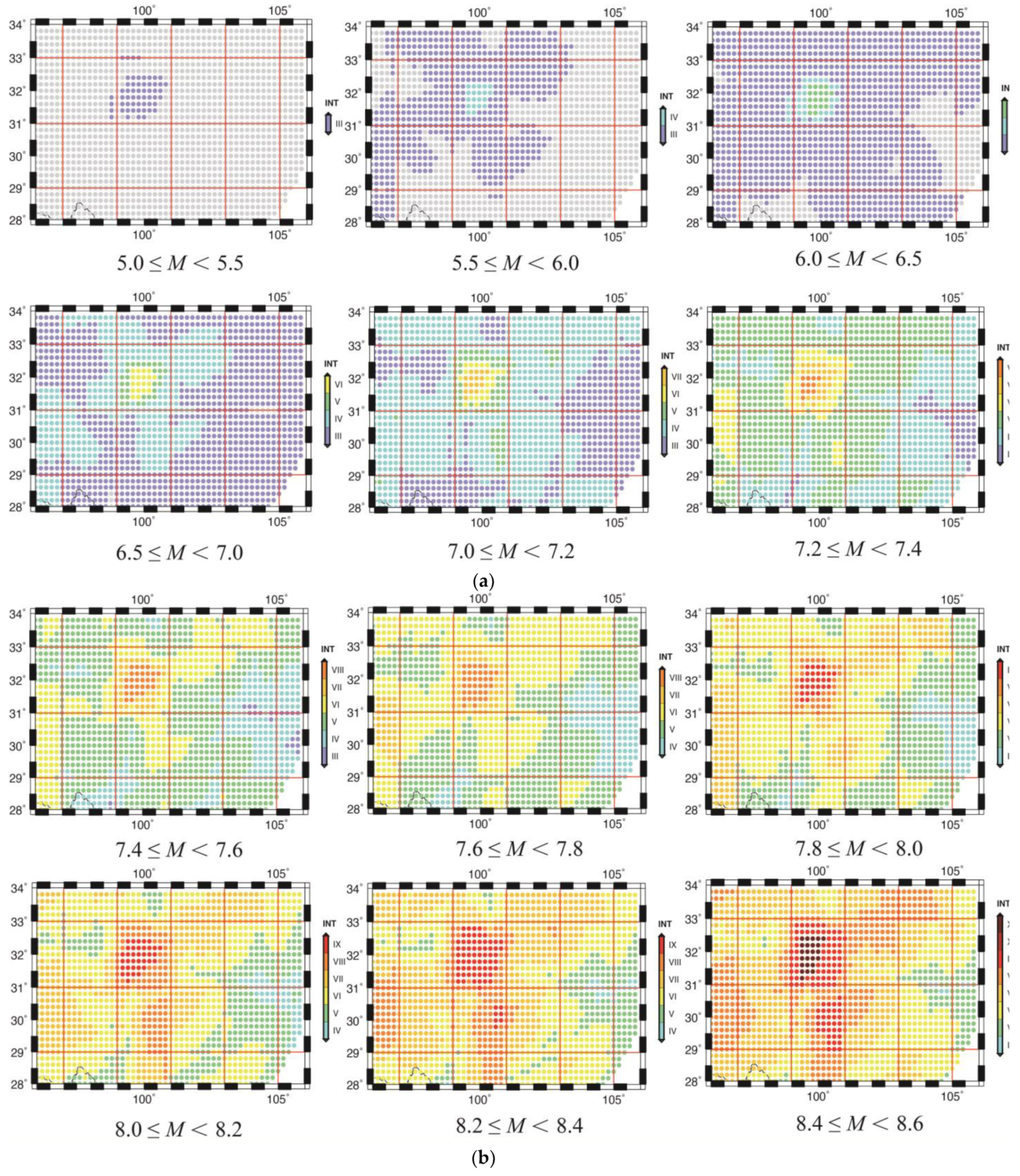

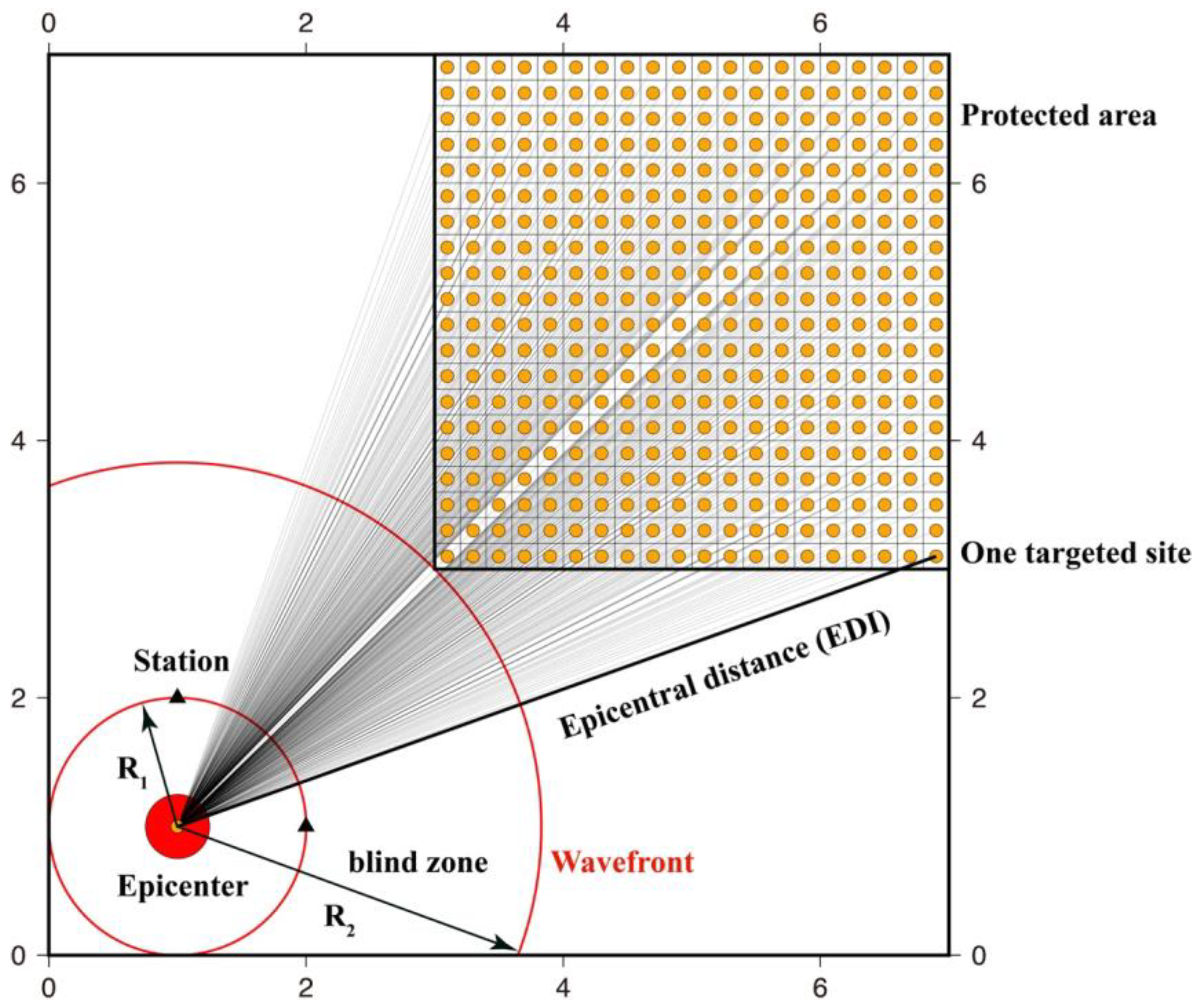
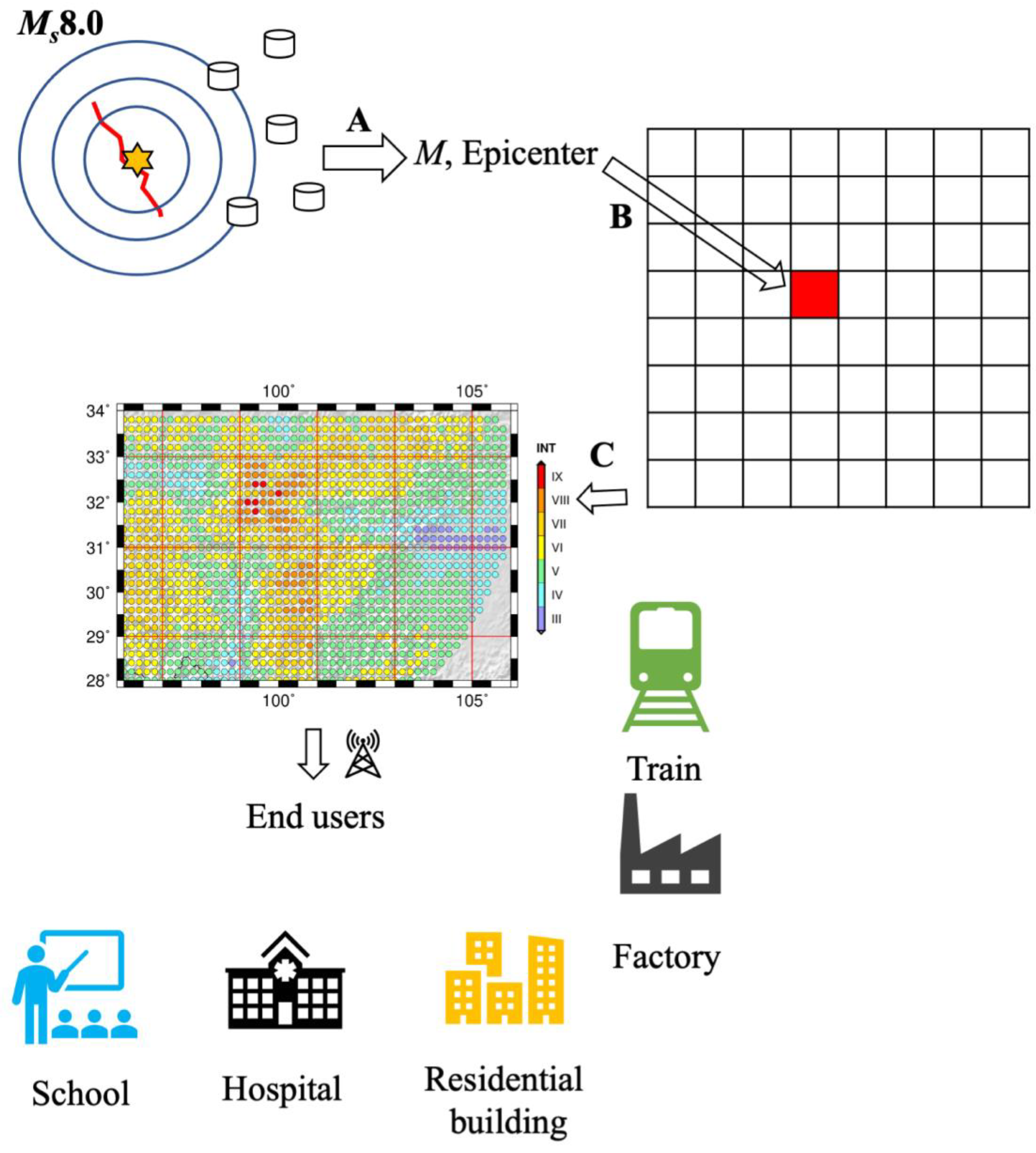
| Earthquake Early Warning | Seismic Hazard Assessment Tools (PSHA, NDSHA) | |
|---|---|---|
| Purposes | Reduction in Seismic Risk | |
| Time length | After earthquakes, a few seconds to a few tens of seconds [46] | Before earthquakes, long- to intermediate-term prediction (PSHA: ≥50 years, e.g., [47]; NDSHA: from a few years to tens of years, e.g., [43]) |
| Input | First seconds of primary P waves | Historical earthquake catalogue, seismogenic zones, structural models (only for NDSHA), focal mechanism (only for NDSHA), seismogenic nodes (only for NDSHA) |
| Output | Lead time and estimated ground motion values | Seismic hazard in terms of probabilistic-based or deterministic-based ground motion values |
| Advantages | Prepare time for emergence responses | Prepare descriptions for future seismic hazard distribution |
| Disadvantages | Missed or false alarms [48], blind zones | Underestimation and nonphysical-based (PSHA, e.g., [49]) |
| Class | |||
|---|---|---|---|
| A | |||
| B | |||
| C | |||
| D | |||
| E |
| Class | Magnitude | Earthquake Effects |
|---|---|---|
| Minor | 3.0~3.9 | May be felt |
| Light | 4.0~4.9 | Likely felt |
| Moderate | 5.0~5.9 | Minor damage may occur |
| Strong | 6.0~6.9 | Damage may occur |
| Major | 7.0~7.9 | Damage expected |
| Great | 8.0 or larger | Significant damage expected |
Publisher’s Note: MDPI stays neutral with regard to jurisdictional claims in published maps and institutional affiliations. |
© 2021 by the authors. Licensee MDPI, Basel, Switzerland. This article is an open access article distributed under the terms and conditions of the Creative Commons Attribution (CC BY) license (https://creativecommons.org/licenses/by/4.0/).
Share and Cite
Zhang, Y.; Wu, Z.; Romanelli, F.; Vaccari, F.; Jiang, C.; Gao, S.; Li, J.; Kossobokov, V.G.; Panza, G.F. Next-Generation EEW Empowered by NDSHA: From Concept to Implementation. Geosciences 2021, 11, 473. https://doi.org/10.3390/geosciences11110473
Zhang Y, Wu Z, Romanelli F, Vaccari F, Jiang C, Gao S, Li J, Kossobokov VG, Panza GF. Next-Generation EEW Empowered by NDSHA: From Concept to Implementation. Geosciences. 2021; 11(11):473. https://doi.org/10.3390/geosciences11110473
Chicago/Turabian StyleZhang, Yan, Zhongliang Wu, Fabio Romanelli, Franco Vaccari, Changsheng Jiang, Shanghua Gao, Jiawei Li, Vladimir G. Kossobokov, and Giuliano F. Panza. 2021. "Next-Generation EEW Empowered by NDSHA: From Concept to Implementation" Geosciences 11, no. 11: 473. https://doi.org/10.3390/geosciences11110473
APA StyleZhang, Y., Wu, Z., Romanelli, F., Vaccari, F., Jiang, C., Gao, S., Li, J., Kossobokov, V. G., & Panza, G. F. (2021). Next-Generation EEW Empowered by NDSHA: From Concept to Implementation. Geosciences, 11(11), 473. https://doi.org/10.3390/geosciences11110473







